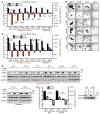Cotargeting a MYC/eIF4A-survival axis improves the efficacy of KRAS inhibitors in lung cancer
- PMID: 37384411
- PMCID: PMC10425214
- DOI: 10.1172/JCI167651
Cotargeting a MYC/eIF4A-survival axis improves the efficacy of KRAS inhibitors in lung cancer
Abstract
Despite the success of KRAS G12C inhibitors in non-small cell lung cancer (NSCLC), more effective treatments are needed. One preclinical strategy has been to cotarget RAS and mTOR pathways; however, toxicity due to broad mTOR inhibition has limited its utility. Therefore, we sought to develop a more refined means of targeting cap-dependent translation and identifying the most therapeutically important eukaryotic initiation factor 4F complex-translated (eIF4F-translated) targets. Here, we show that an eIF4A inhibitor, which targets a component of eIF4F, dramatically enhances the effects of KRAS G12C inhibitors in NSCLCs and together these agents induce potent tumor regression in vivo. By screening a broad panel of eIF4F targets, we show that this cooperativity is driven by effects on BCL-2 family proteins. Moreover, because multiple BCL-2 family members are concomitantly suppressed, these agents are broadly efficacious in NSCLCs, irrespective of their dependency on MCL1, BCL-xL, or BCL-2, which is known to be heterogeneous. Finally, we show that MYC overexpression confers sensitivity to this combination because it creates a dependency on eIF4A for BCL-2 family protein expression. Together, these studies identify a promising therapeutic strategy for KRAS-mutant NSCLCs, demonstrate that BCL-2 proteins are the key mediators of the therapeutic response in this tumor type, and uncover a predictive biomarker of sensitivity.
Keywords: Drug therapy; Lung cancer; Oncology; Signal transduction.
Conflict of interest statement
Figures









Comment in
-
eIF4A dependency: the hidden key to unlock KRAS mutant non-small cell lung cancer's vulnerability.Transl Lung Cancer Res. 2023 Dec 26;12(12):2570-2575. doi: 10.21037/tlcr-23-682. Epub 2023 Dec 22. Transl Lung Cancer Res. 2023. PMID: 38205207 Free PMC article. No abstract available.
References
-
- Hallin J, et al. The KRASG12C inhibitor MRTX849 provides insight toward therapeutic susceptibility of KRAS-mutant cancers in mouse models and patients. Cancer Discov. 2020;10(1):54–71. doi: 10.1158/2159-8290.CD-19-1167. - DOI - PMC - PubMed
-
- Li B, et al. PS01.07 registrational phase 2 trial of sotorasib in KRAS p.G12C mutant NSCLC: first disclosure of the codebreak 100 primary analysis. J Thorac Oncol. 2021;16(3):S61. doi: 10.1016/j.jtho.2021.01.321. - DOI
-
- Riely GJ, et al. 99O_PR KRYSTAL-1: activity and preliminary pharmacodynamic (PD) analysis of adagrasib (MRTX849) in patients (Pts) with advanced non–small cell lung cancer (NSCLC) harboring KRASG12C mutation. J Thorac Oncol. 2021;16(4):S751–S752. doi: 10.1016/S1556-0864(21)01941-9. - DOI
Publication types
MeSH terms
Substances
Grants and funding
LinkOut - more resources
Full Text Sources
Medical
Research Materials
Miscellaneous

